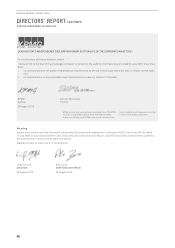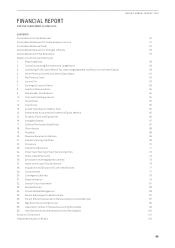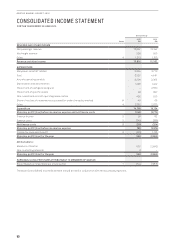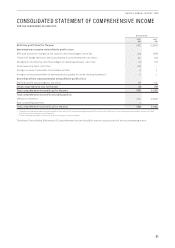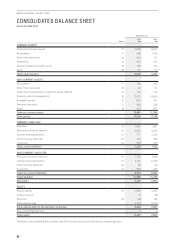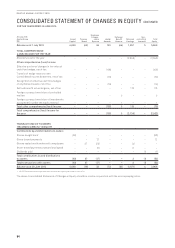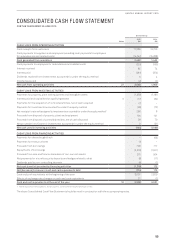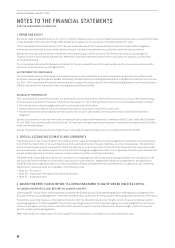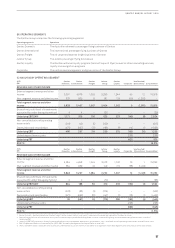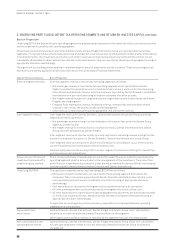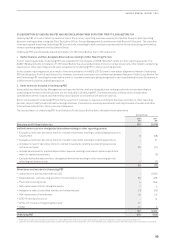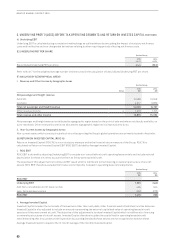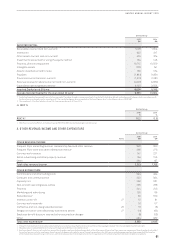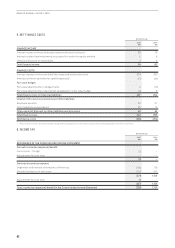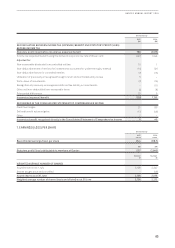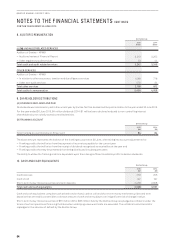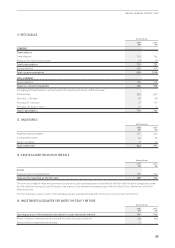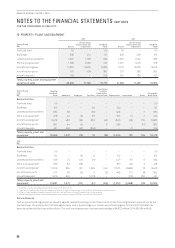Qantas 2015 Annual Report Download - page 59
Download and view the complete annual report
Please find page 59 of the 2015 Qantas annual report below. You can navigate through the pages in the report by either clicking on the pages listed below, or by using the keyword search tool below to find specific information within the annual report.
58
QANTAS ANNUAL REPORT 2015
3. UNDERLYING PROFIT/(LOSS) BEFORE TAX,OPERATING SEGMENTS AND RETURN ON INVESTED CAPITAL CONTINUED
Basis of Preparation
Underlying EBIT of the Qantas Group’s operating segments is prepared and presented on the basis that reflects the revenue earned
and the expenses incurred by each operating segment.
All revenues earned and expenses incurred by Qantas Loyalty, Qantas Freight and Jetstar Group are reported directly by these
segments. For Qantas Airlines where revenues earned and expenses incurred are directly attributable to either Qantas International
or Qantas Domestic, they have been reported as such. Where revenues earned and expenses incurred by Qantas Airlines are not
individually attributable to either Qantas International or Qantas Domestic, they are reported by these operating segments using an
appropriate allocation methodology.
The significant accounting policies applied in implementing this basis of preparation are set out below. These accounting policies
have been consistently applied to all periods presented in the Consolidated Financial Statements.
Segment Performance Measure Basis of Preparation
External segment revenue External segment revenue is reported by operating segments as follows:
–Net passenger revenue is reported by the operating segment which operated the relevant
flight or provided the relevant service. For Qantas Airlines, where a multi-sector ticket covering
international and domestic travel is sold, the revenue is reported by Qantas Domestic and Qantas
International on a pro-rata basis using an industry standard allocation process.
–Net freight revenue includes air cargo and express freight revenue and is reported by the Qantas
Freight operating segment.
–Frequent Flyer redemption revenue, marketing revenue, membership fees and other related
revenue is reported by the Qantas Loyalty operating segment.
–Other revenue is reported by the operating segment that earned the revenue.
Inter-segment revenue Inter-segment revenue for Qantas Domestic, Qantas International and Jetstar Group operating
segments primarily represents:
–Net passenger revenue arising from the redemption of frequent flyer points for Qantas Group
flights by Qantas Loyalty
–Net freight revenue from the utilisation of Qantas Domestic, Qantas International and Jetstar
Group’s aircraft bellyspace by Qantas Freight
Inter-segment revenue for Qantas Loyalty primarily represents marketing revenue arising from the
issuance of frequent flyer points to Qantas Domestic, Qantas International and Jetstar Group.
Inter-segment revenue transactions, which are eliminated on consolidation, occur in the ordinary
course of business at prices that approximate market prices.
Qantas Loyalty does not derive net profit from inter-segment transactions relating to frequent flyer
point issuances and redemptions.
Share of net profit/(loss) of
investments accounted for
under the equity method
Share of net profit/(loss) of investments accounted for under the equity method is reported by the
operating segment which is accountable for the management of the investment. The share of net
profit/(loss) of investments accounted for under the equity method for Qantas Airlines’ investments
has been equally shared between Qantas Domestic and Qantas International.
Underlying EBITDAR The significant expenses impacting Underlying EBITDAR are as follows:
–Manpower and staff related costs are reported by the operating segment that utilises the
manpower. Where manpower supports both Qantas Domestic and Qantas International, costs
are reported by Qantas Domestic and Qantas International using an appropriate allocation
methodology.
–Fuel expenditure is reported by the segment that consumes the fuel in its operations.
–Aircraft operating variable costs are reported by the segment that incurs these costs.
–All other expenditure is reported by the operating segment to which they are directly attributable
or, in the case of Qantas Airlines, between Qantas Domestic and Qantas International using an
appropriate allocation methodology.
To apply this accounting policy, where necessary, expenditure is recharged between operating
segments as a cost recovery.
Depreciation and
amortisation
Qantas Domestic, Qantas International, Qantas Freight and Jetstar Group report depreciation
expense for aircraft owned by the Qantas Group and flown by the segment.
Other depreciation and amortisation is reported by the segment that uses the related asset.
Non-cancellable aircraft
operating lease rentals
Qantas Domestic, Qantas International, Qantas Freight and Jetstar Group report non-cancellable
aircraft operating lease rentals for aircraft externally leased by the Qantas Group and flown by
thesegment.


